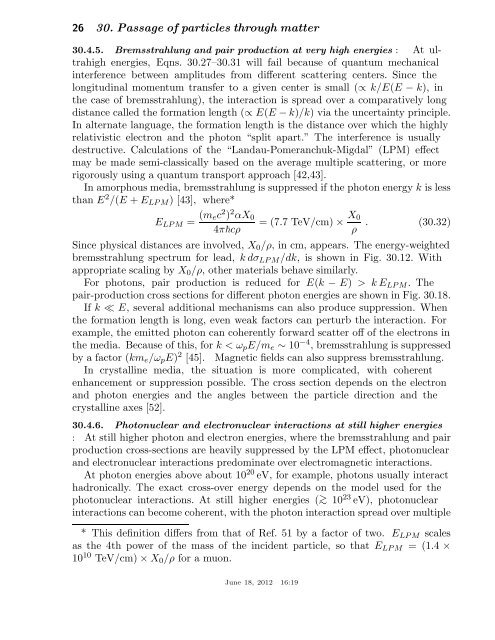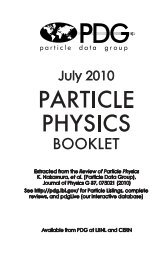30. Passage of particles through matter 1 - Particle Data Group
30. Passage of particles through matter 1 - Particle Data Group
30. Passage of particles through matter 1 - Particle Data Group
Create successful ePaper yourself
Turn your PDF publications into a flip-book with our unique Google optimized e-Paper software.
26 <strong>30.</strong> <strong>Passage</strong> <strong>of</strong> <strong>particles</strong> <strong>through</strong> <strong>matter</strong><br />
<strong>30.</strong>4.5. Bremsstrahlung and pair production at very high energies : At ultrahigh<br />
energies, Eqns. <strong>30.</strong>27–<strong>30.</strong>31 will fail because <strong>of</strong> quantum mechanical<br />
interference between amplitudes from different scattering centers. Since the<br />
longitudinal momentum transfer to a given center is small (∝ k/E(E − k), in<br />
the case <strong>of</strong> bremsstrahlung), the interaction is spread over a comparatively long<br />
distance called the formation length (∝ E(E − k)/k) via the uncertainty principle.<br />
In alternate language, the formation length is the distance over which the highly<br />
relativistic electron and the photon “split apart.” The interference is usually<br />
destructive. Calculations <strong>of</strong> the “Landau-Pomeranchuk-Migdal” (LPM) effect<br />
may be made semi-classically based on the average multiple scattering, or more<br />
rigorously using a quantum transport approach [42,43].<br />
In amorphous media, bremsstrahlung is suppressed if the photon energy k is less<br />
than E 2 /(E + ELPM) [43], where*<br />
ELPM = (mec 2 ) 2 αX0<br />
4π�cρ<br />
= (7.7 TeV/cm) × X0<br />
ρ<br />
. (<strong>30.</strong>32)<br />
Since physical distances are involved, X0/ρ, in cm, appears. The energy-weighted<br />
bremsstrahlung spectrum for lead, k dσLPM/dk, is shown in Fig. <strong>30.</strong>12. With<br />
appropriate scaling by X0/ρ, other materials behave similarly.<br />
For photons, pair production is reduced for E(k − E) > k ELPM. The<br />
pair-production cross sections for different photon energies are shown in Fig. <strong>30.</strong>18.<br />
If k ≪ E, several additional mechanisms can also produce suppression. When<br />
the formation length is long, even weak factors can perturb the interaction. For<br />
example, the emitted photon can coherently forward scatter <strong>of</strong>f <strong>of</strong> the electrons in<br />
the media. Because <strong>of</strong> this, for k < ωpE/me ∼ 10 −4 , bremsstrahlung is suppressed<br />
by a factor (kme/ωpE) 2 [45]. Magnetic fields can also suppress bremsstrahlung.<br />
In crystalline media, the situation is more complicated, with coherent<br />
enhancement or suppression possible. The cross section depends on the electron<br />
and photon energies and the angles between the particle direction and the<br />
crystalline axes [52].<br />
<strong>30.</strong>4.6. Photonuclear and electronuclear interactions at still higher energies<br />
: At still higher photon and electron energies, where the bremsstrahlung and pair<br />
production cross-sections are heavily suppressed by the LPM effect, photonuclear<br />
and electronuclear interactions predominate over electromagnetic interactions.<br />
At photon energies above about 10 20 eV, for example, photons usually interact<br />
hadronically. The exact cross-over energy depends on the model used for the<br />
photonuclear interactions. At still higher energies (> ∼ 10 23 eV), photonuclear<br />
interactions can become coherent, with the photon interaction spread over multiple<br />
* This definition differs from that <strong>of</strong> Ref. 51 by a factor <strong>of</strong> two. ELPM scales<br />
as the 4th power <strong>of</strong> the mass <strong>of</strong> the incident particle, so that ELPM = (1.4 ×<br />
10 10 TeV/cm) × X0/ρ for a muon.<br />
June 18, 2012 16:19







